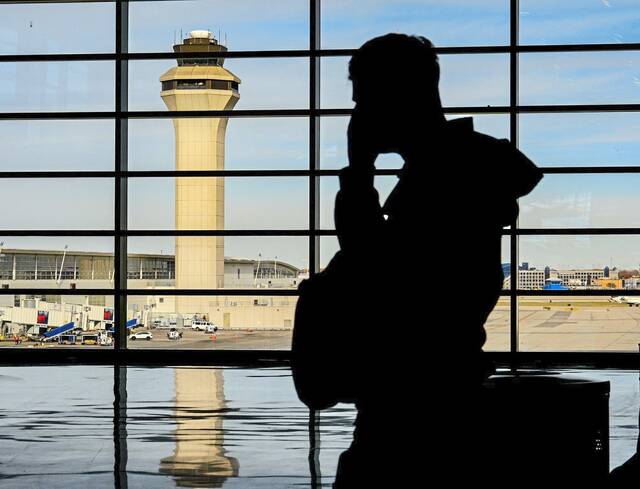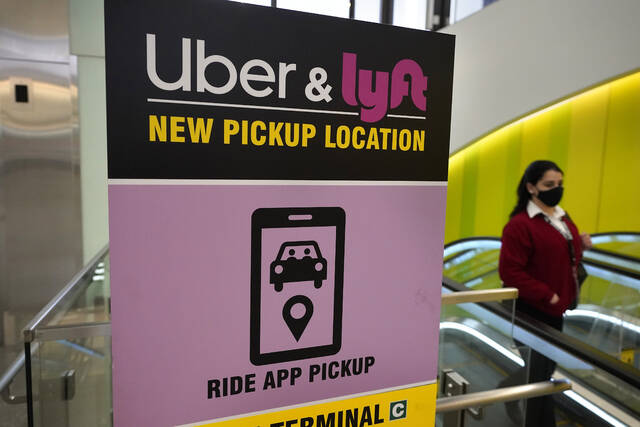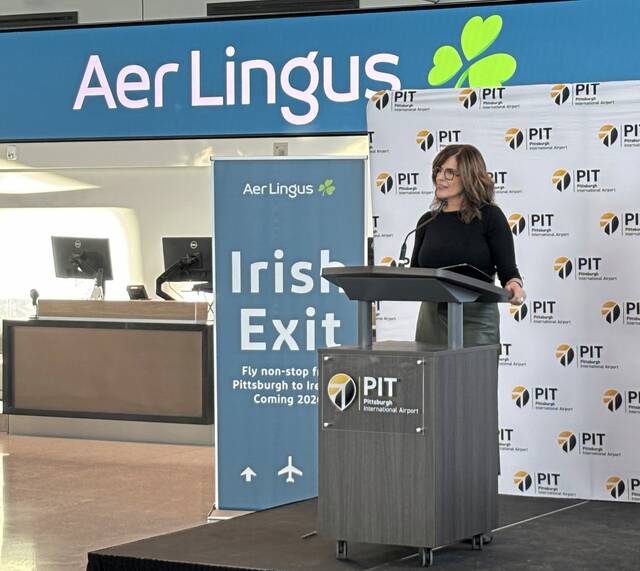Transportation Secretary Sean Duffy on Tuesday warned that flight disruptions could skyrocket in the coming days if the House of Representatives does not vote to end the longest government shutdown in U.S. history.
Ongoing government-mandated flight cancellations and severe weather in parts of the country wreaked havoc on air travel. In a news conference Tuesday afternoon from Chicago O’Hare International Airport, Duffy urged lawmakers to approve the bipartisan bill to reopen the government.
“If the House doesn’t act, I think we’ll see more than 10% disruption — and possibly airlines grounding planes altogether,” Duffy said. “That’s how serious this is.”
As of Tuesday night, FlightAware data showed more than 1,200 cancellations and over 3,600 delays for flights within, into, or out of the United States. Monday saw over 2,400 cancellations, while more than 14,000 total disruptions occurred on Sunday.
As of 8:45 a.m., Pittsburgh International Airport had reported four cancellations and six delays, according to FlightAware.
The percentage of flights required to be cut by the Federal Aviation Administration was originally expected to increase to 6% from 4% at 40 major airports on Tuesday, the first bump on the ramp-up to a full 10% of cuts by Friday. Duffy said Tuesday that he will reduce flight cuts as safety allows.
“When that data changes, we’re going to start taking that down from 6%, maybe we’ll go to four, two, and get back to normal air travel,” he said. “It depends on controllers coming back to work.”
Air traffic control staffing shortages improved on Tuesday after more than two dozen issues on Monday. Duffy said just four staffing issues were reported Tuesday, down from 81 on Saturday.
Thousands of flights have been cut since Duffy ordered the cancellations to begin last Friday, Nov. 7. On Monday, the travel woes were compounded by a Chicago-area winter storm that grounded even more flights.
Flight cancellations improve after days of travel chaos
Air traffic control staffing shortages, along with weather issues, have led to tens of thousands of flight cancellations and delays since Oct. 1, when the government shutdown began.
Over the weekend, 1.2 million passengers were delayed or had their flights cancelled due to air traffic controller absences, according to Reuters. FlightAware data showed 1,025 cancellations on Friday and 1,566 on Saturday for flights “within, into, or out of the United States.”
Flight cancellations jumped to 2,954 on Sunday and 2,422 on Monday, according to FlightAware. By 8:40 p.m. Tuesday, data showed that 1,254 flights had been cancelled as air traffic control staffing improved for the day.
Airlines, FAA talk flight cuts
The FAA ordered airlines to cut 4% of daily flights — starting Nov. 7 — at 40 major airports due to air traffic control staffing issues. Reductions in flights rose to 6% on Tuesday.
The reductions were set to hit 8% on Thursday and 10% on Friday. Reuters reported that some airlines were holding off on cutting 8% of flights for Thursday. United Airlines said Tuesday it cut about 5% of its flights for Thursday.
Airlines and the FAA said they are in discussions about when the cuts will stop as the government shutdown nears an end. Experts previously told USA TODAY that the impact on air travel will stretch well beyond the shutdown’s end as airlines work to untangle complicated flight schedules and recover from staff shortages.
“It’s going to be a step-up, phased-in approach to cutting flights,” said Henry Harteveldt, president of Atmosphere Research Group, an independent travel analytics firm. “For an airline to be told by the government they’ve got 36 or so hours to start dismembering their carefully built flight schedules doesn’t give airlines a lot of time.”
$10K bonuses for FAA employees?
President Donald Trump has alternatively threatened to “dock” the pay of workers who don’t show or told them to quit and promised $10,000 bonuses for employees who continued working.
Duffy called the president’s offered bonuses “brilliant” while stopping short of guaranteeing them.
“The air traffic controllers who didn’t miss a day, they came for every scheduled shift that they had. They should get a bonus,” said Duffy, adding that the exact amount would be contingent on an analysis. He called the workers “patriots” and said they should be invited to the White House to receive their checks.
He also stopped short of telling workers who failed to show up not to return.
“I’m concerned about those controllers. I’m concerned about their dedication. I’m concerned about their patriotism,” the secretary said. “We haven’t made a decision, but we are going to look at those controllers.”
Duffy promises modernization of air traffic tech
Among goals for the FAA under Duffy, the transportation secretary promised to modernize equipment air traffic controllers use.
“Air traffic controllers need brand new equipment,” said Duffy, noting air traffic controllers are still using paper flight strips, which he called “great 1985 technology” but outdated. “It’s a blast from the past but we should live today and technology from today.”
Congress has allocated $12.5 billion to the FAA, said Duffy, short of the $31.5 billion he says is needed for the program he envisions.
In addition to changing to digital flight strips, the secretary said he wants to build a digital platform for managing the skies. Duffy estimated the program would take more than three years. He said the agency would likely look to hire a private company for the project.
“The FAA does a great job at safety, they don’t know how to build,” Duffy said. We’re going to have radios, new voice switches, new radar, new telecom, we’re going to have to switch from analog to digital.”
When can air traffic controllers expect to be paid?
Air traffic controllers will receive 70% of their back pay within 24 to 48 hours after the government reopens, with the remaining 30% arriving about a week later, Duffy said at a news conference Tuesday.
“They’re going to get money in their bank accounts very quickly,” he said, thanking Congress for ensuring controllers are “made whole” after working without pay during the shutdown.
Shortages of air traffic controllers are one of the key reasons the FAA ordered flight reductions at 40 airports across the nation starting Nov. 7. He said the FAA is still short about 2,000 air traffic controllers.
Delta, Southwest continue with planned cancellations
In an update Tuesday, Delta Air Lines said its operations remained stable amid air traffic control constraints. The airline noted that it expects to “operate the vast majority” of its flight schedule and continues to coordinate with the FAA.
“Planned FAA-directed cancellations are complete through Nov. 13,” the airline said. “Additional delays and cancels may be necessary if Air Traffic Control constraints continue in the National Airspace System.”
Meanwhile, Southwest Airlines has said it reduced its flight schedule through Wednesday across 34 airports. According to the airline, the majority of customers’ flights have not been disrupted.
“For Tuesday, we removed roughly 155 flights from the schedule, and 145 on Wednesday to meet the FAA’s requirements,” the airline said. “International flights are exempt from the restrictions.”
Can you cancel your flight and get a refund?
The four major airline operators in the U.S. — Delta Air Lines, United Airlines, Southwest Airlines, and American Airlines — have canceled hundreds of flights to adhere to the FAA’s reduction demands.
The good news for stressed travelers? All four carriers have nixed the usual fines and fees that would apply to last-minute changes and cancellations, even for tickets that are usually non-refundable.
And smaller mainland U.S. airlines, including JetBlue, Alaska/Hawaiian Airlines, Spirit, and Frontier, are taking a cue from the big four, offering similar fee-free changes and cancellations. Here’s what to know about how to change or cancel your trip.
Will flight disruptions impact Thanksgiving travel?
Though mandated flight cuts impact 40 of the nation’s airports and air carriers are mainly cutting service through their regional partners, meaning flights between large hubs and smaller cities and towns are most likely to be affected, the entire system has become discombobulated. The effects are likely to stretch into the Thanksgiving holiday.
“Typically, with a storm, one airline can recover operations within 48 to 72 hours after the weather event has finished ‒ but that’s when one hub is impacted,” Tiffany Funk, co-founder and president of the travel-tech company point.me, said. “This is unprecedented, and it’s also storm season. I don’t think we’ll see equal recovery. Airports will come online at different rates, which means airlines won’t be equally impacted.”
Airlines for America, the industry’s main trade group, warned that “more than 3.5 million passengers have experienced delays or cancellations because of air-traffic-control staffing concerns since the shutdown began,” calling the situation “not sustainable” with an all-time-high 31 million passengers expected between Nov. 21 and Dec. 1.
If you’re traveling this week, here’s what to expect
Despite the government shutdown expected to come to a close, travelers should still brace for delays and cancellations in the coming days.
“I would expect really bumpy operations and pretty brutal travel experiences, at least throughout the week,” said Tiffany Funk, co-founder and president of point.me, which specializes in points-based travel. “Even if funding were magically restored today, this is going to take a long time to reset.”
The longer the cancellations and flight disruptions continue, the longer it will take to restore, experts told USA TODAY, and the pace of recovery could vary at different airports and across airlines. Air traffic controllers, whose work can include long hours and mandated overtime, may not immediately return to work in full force.
In the meantime, Ahmed Abdelghany, associate dean for research at the David B. O’Maley College of Business at Embry-Riddle Aeronautical University, recommended travelers keep an eye on their flight’s status via the airline’s mobile app or website, and get to the airport “well in advance” in case there are long waits at security. He said it’s worth considering rebooking options — if flyers can travel at another time — and purchasing travel insurance, which may reimburse some costs if there are hiccups. And if you don’t have to travel now, consider putting it off.








